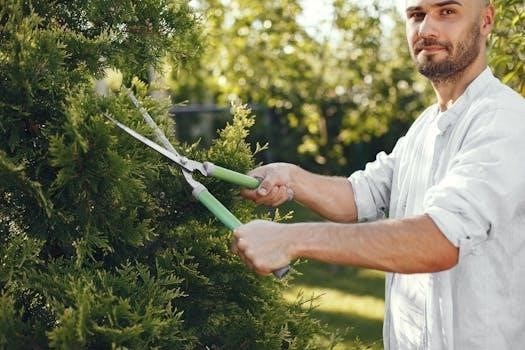
manual pole pruner
Manual Pole Pruner⁚ A Comprehensive Guide
A manual pole pruner is a versatile tool for maintaining trees and shrubs. It allows users to reach high branches without using a ladder. They offer a safe and efficient way to care for your garden and are a smart investment, providing superb control.
Understanding Manual Pole Pruners
Manual pole pruners, also known as manual pole saws or tree pruners, are versatile tools designed for trimming branches that are difficult to reach. These tools typically consist of a long, extendable pole with a pruning head or saw blade attached at the end. Unlike their powered counterparts, manual pole pruners rely on the user’s physical effort to operate, making them a more eco-friendly and cost-effective option for homeowners and professionals alike.
The primary function of a manual pole pruner is to provide a safe and efficient way to trim trees without the need for ladders or climbing; This reduces the risk of falls and injuries, making it a safer alternative for maintaining trees around your property. The extendable pole allows users to reach branches at varying heights, providing greater flexibility and control over the pruning process. Manual pole pruners are particularly useful for tasks such as removing dead or diseased branches, shaping trees, and thinning out dense foliage.
Manual pole pruners are favored for their simplicity, ease of use, and portability. They require no electricity or fuel, making them ideal for remote locations or areas where power access is limited.
Types of Manual Pole Saws
Manual pole saws come in several types, each designed with specific features to tackle different pruning tasks. Understanding these variations is crucial for selecting the right tool for your needs. The most common types include⁚
Pruning Head Pole Pruners⁚ These feature a cutting head with bypass or anvil blades, operated by a rope and pulley system. Bypass pruners make clean, precise cuts, ideal for live branches. Anvil pruners crush branches, better suited for deadwood.
Pole Saws⁚ These have a saw blade at the end of the pole, designed for cutting thicker branches. Blades can be fixed or replaceable, with various tooth designs for different cutting speeds and materials. Some pole saws also include a pruning head for added versatility.
Telescopic Pole Saws⁚ Telescopic models have adjustable poles, allowing users to extend or retract the length for different reach requirements. These are convenient for varying tree heights.
Fixed-Length Pole Saws⁚ Fixed-length saws offer a set reach without adjustability. They are often more rigid and durable than telescopic models.
The choice depends on the types of branches you’ll be cutting and the desired reach.
Key Features to Consider When Buying

When purchasing a manual pole pruner, several key features can significantly impact its performance and usability. Evaluating these aspects will ensure you select the best tool for your specific needs.
Reach and Length⁚ Consider the maximum extended length of the pole. Ensure it is adequate for reaching the highest branches you intend to prune. Telescopic models offer adjustable lengths, providing greater versatility.
Weight⁚ A lightweight pruner minimizes fatigue during extended use. Look for models made from materials like aluminum or fiberglass. Balance is also important for comfortable handling.
Cutting Capacity⁚ Check the maximum branch diameter the pruner can handle; Pruning heads typically cut smaller branches, while saw blades tackle larger ones.
Blade Quality⁚ High-quality steel blades stay sharp longer and provide cleaner cuts. Look for features like hardened teeth.
Grip Comfort⁚ Ergonomic grips reduce strain and improve control. Padded or textured grips offer a secure and comfortable hold.
Safety Features⁚ Consider safety features like secure locking mechanisms for telescopic poles.
Best Manual Pole Saws⁚ A Comparison
Selecting the best manual pole saw depends on individual needs and preferences. Several models stand out in terms of performance, durability, and features. Let’s compare some top contenders⁚
Notch 40207⁚ This is a top choice for professionals, offering flawless cuts and robust construction.

Milliard 6-16 Pole Saw⁚ Ideal for heavy-duty pruning tasks, this saw provides excellent reach and cutting power.
Corona TP 4210⁚ Perfect for light-duty tasks around the home, this pruner is lightweight and easy to operate.
Jameson FG Series⁚ Known for their durable fiberglass poles and versatile cutting heads, Jameson pruners are a reliable option;
Silky HAYAUCHI⁚ Renowned for its exceptional blade quality and extended reach, this saw excels in precision cutting.
Fiskars Power-Lever Extendable Pole Saw & Pruner⁚ This model stands out with its Power-Lever technology, providing double the cutting power.
Each of these saws offers unique advantages. Consider your specific pruning needs, budget, and desired features when making your selection.
Top Brands⁚ Silky, Fiskars, Jameson, Corona, Notch
When it comes to manual pole pruners, certain brands consistently deliver exceptional quality and performance. Here’s a closer look at some of the top names in the industry⁚
Silky⁚ A Japanese manufacturer celebrated for its high-grade steel and superior craftsmanship. Silky pole saws are known for their sharpness, durability, and smooth cutting action, often favored by professionals.
Fiskars⁚ A well-known brand offering a range of user-friendly and efficient pruning tools. Fiskars pole saws are designed for ease of use and durability, making them a popular choice for homeowners.
Jameson⁚ Specializing in landscaping and tree care equipment since 1956, Jameson provides robust and reliable pole pruners. Their products are known for their sturdy construction and suitability for heavy-duty tasks.
Corona⁚ Corona offers a variety of pruning tools, including pole saws that balance quality and affordability. Their pruners are designed for both homeowners and professionals.
Notch⁚ Notch pole saws are engineered for professional landscaping and tree care. They are recognized for their exceptional cutting performance and durability.
Safety Tips for Using Manual Pole Pruners
Using a manual pole pruner requires caution to prevent injuries. Always inspect the pruner before use, ensuring all parts are secure and in good working condition. Wear appropriate safety gear, including eye protection, a hard hat, and gloves. Position yourself on stable ground, maintaining a balanced stance to avoid falls.
Keep a safe distance from power lines and be aware of your surroundings. Avoid pruning during wet or windy conditions, as these increase the risk of accidents. When cutting, use smooth, controlled motions and avoid overreaching. Never stand directly beneath the branch you are cutting.
Be mindful of the pruner’s reach and avoid extending it beyond its limit. Take breaks to prevent fatigue, which can lead to mistakes. Store the pole pruner in a safe, dry place when not in use, and keep it out of reach of children.
If using a telescoping pole, ensure it is fully extended and locked before cutting. Familiarize yourself with the pruner’s operating mechanism and follow the manufacturer’s instructions.
Maintenance and Care for Longevity
Proper maintenance is essential for extending the life of your manual pole pruner. After each use, clean the blade with a damp cloth to remove sap, debris, and dirt. For stubborn residue, use a specialized resin remover or mild soap and water. Dry the blade thoroughly to prevent rust and corrosion.
Regularly sharpen the blade to maintain its cutting efficiency. A dull blade requires more force, increasing the risk of accidents and damaging the tool. Use a sharpening stone or file, following the manufacturer’s instructions for the correct angle and technique. Lubricate the moving parts, such as the pivot points and telescoping mechanism, with a light oil to ensure smooth operation.
Inspect the pole for any signs of damage, such as cracks, dents, or bends. Replace any damaged parts immediately to prevent further issues. Store the pole pruner in a dry, sheltered location to protect it from the elements. Avoid storing it in direct sunlight or extreme temperatures, which can cause the materials to degrade.
Periodically check the tightness of all bolts and screws, and tighten them as needed. By following these maintenance tips, you can ensure that your manual pole pruner remains in optimal condition for years to come.
Advantages of Manual Pole Pruners

Manual pole pruners offer several advantages over other types of tree trimming tools. One of the primary benefits is their cost-effectiveness. They are generally less expensive than gas-powered or electric models, making them an accessible option for homeowners on a budget. Additionally, manual pole pruners are environmentally friendly, as they do not require fuel or electricity to operate. This eliminates emissions and reduces your carbon footprint.

These tools are also lightweight and easy to maneuver. Their simple design makes them easy to use and maintain, without the need for specialized knowledge or equipment. Manual pole pruners are quiet during operation, which is a significant advantage in noise-sensitive environments.
They provide a high degree of control, allowing for precise cuts and reducing the risk of damaging the tree. The extended reach of manual pole pruners eliminates the need for ladders, enhancing safety and convenience. Their portability is another key advantage, as they can be easily transported and used in remote locations without access to power.
These tools are durable and reliable, designed to withstand regular use and provide long-lasting performance. They are a practical and versatile choice for homeowners.
Disadvantages of Manual Pole Pruners
While manual pole pruners offer several advantages, they also have some notable disadvantages. One of the main limitations is the physical effort required to operate them. Unlike powered pruners, manual models rely entirely on the user’s strength and stamina, which can lead to fatigue during extended use. This can be a significant drawback for individuals with limited upper body strength or those who need to prune many branches.
Manual pole pruners are generally slower than their powered counterparts. Cutting through thick or tough branches can be time-consuming and require considerable effort. The reach of manual pole pruners is limited by the length of the pole, which may not be sufficient for very tall trees. The precision of cuts can also be affected by the user’s stability and control, especially when working at maximum extension.
These tools may not be suitable for heavy-duty or commercial applications, where efficiency and speed are essential. The need for manual operation can also increase the risk of repetitive strain injuries, particularly with frequent use.
Despite their cost-effectiveness, the physical demands and limitations of manual pole pruners make them less ideal for large-scale or professional tree care tasks.
Applications⁚ Homeowners vs. Professionals
Manual pole pruners serve different needs for homeowners and professionals, leading to varying application scenarios. For homeowners, these tools are ideal for light-duty tasks such as trimming small trees, removing dead branches, and maintaining the aesthetic appeal of their gardens. The ease of use, low maintenance, and affordability of manual pole pruners make them a practical choice for occasional pruning needs.
Homeowners often appreciate the quiet operation of manual pruners, allowing them to work without disturbing neighbors. The portability and compact storage of these tools are also beneficial for those with limited space. Professionals, on the other hand, require more robust and efficient tools to handle demanding and frequent tasks. While manual pole pruners can be useful for specific situations, such as pruning in noise-sensitive areas or reaching difficult spots, they are generally not the primary choice for professional arborists or landscapers.
Professionals often rely on powered pole saws for their increased cutting power, extended reach, and faster operation. However, manual pole pruners can still be valuable for detail work, precision cuts, or as a backup tool in their arsenal.
The choice between manual and powered pruners ultimately depends on the scale and frequency of the pruning tasks, as well as the user’s physical capabilities and preferences.
Related posts:
Archives
Calendar
| M | T | W | T | F | S | S |
|---|---|---|---|---|---|---|
| 1 | 2 | 3 | 4 | 5 | 6 | 7 |
| 8 | 9 | 10 | 11 | 12 | 13 | 14 |
| 15 | 16 | 17 | 18 | 19 | 20 | 21 |
| 22 | 23 | 24 | 25 | 26 | 27 | 28 |
| 29 | 30 | 31 | ||||
Leave a Reply
You must be logged in to post a comment.